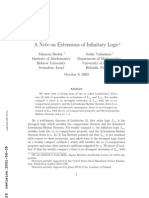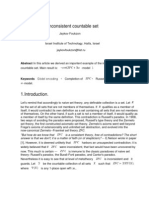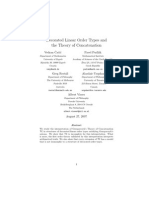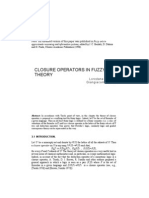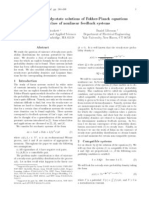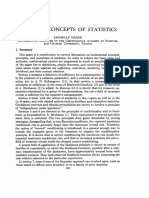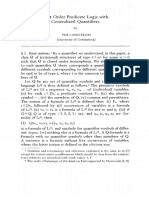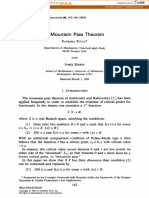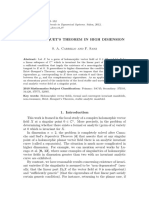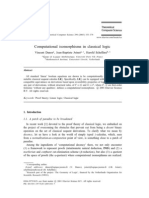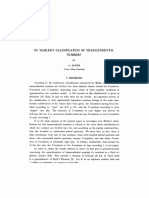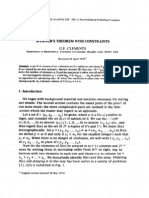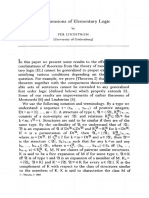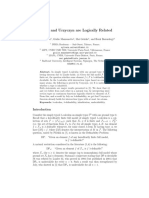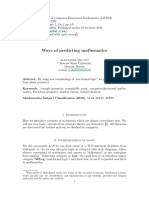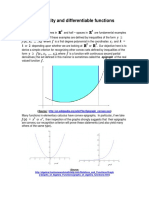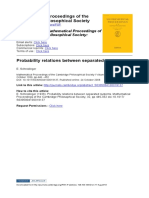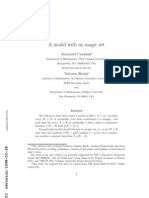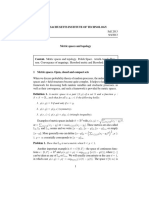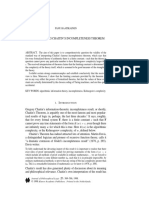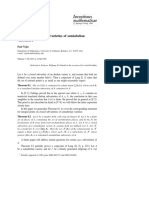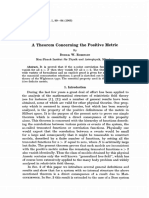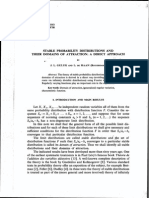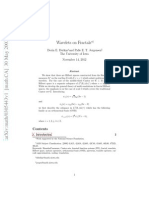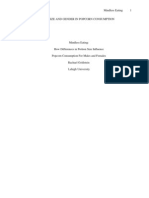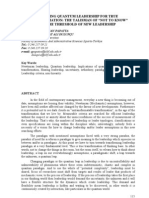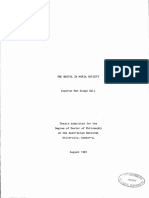On Formalization of Model-Theoretic Proofs of G Odel's Theorems
On Formalization of Model-Theoretic Proofs of G Odel's Theorems
Uploaded by
salnicoCopyright:
Available Formats
On Formalization of Model-Theoretic Proofs of G Odel's Theorems
On Formalization of Model-Theoretic Proofs of G Odel's Theorems
Uploaded by
salnicoOriginal Description:
Original Title
Copyright
Available Formats
Share this document
Did you find this document useful?
Is this content inappropriate?
Copyright:
Available Formats
On Formalization of Model-Theoretic Proofs of G Odel's Theorems
On Formalization of Model-Theoretic Proofs of G Odel's Theorems
Uploaded by
salnicoCopyright:
Available Formats
403
Notre Dame Journal of Formal Logic Volume 35, Number 3, Summer 1994
On Formalization of Model-Theoretic Proofs of Godels Theorems
MAKOTO KIKUCHI and KAZUYUKI TANAKA
Abstract Within a weak subsystem of second-order arithmetic W K L0 , that is 0 2 -conservative over P R A, we reformulate Kreisels proof of the Second Incompleteness Theorem and Boolos proof of the First Incompleteness Theorem.
1 Introduction To bypass the pedagogic obstacles in G odels original proof of the Incomplete Theorems, model-theoretic methods have been invented by several people (cf. Smory nski [7], Boolos [1], and Kreisel [4]). However, such semantic proofs usually need such strong assumptions in metamathematics that they do not readily yield the formalized versions. For instance, as Smory nski [7] points out, Kreisels proof of the Second Incompleteness Theorem in [4] does not directly lead to the formalized Second Incompleteness Theorem: P R A Con ( PA ) Con ( PA + Con ( PA )). In this paper, we elucidate the mechanism of such semantic proofs and show that they can be carried out within a subsystem of second-order arithmetic W K L0 . Thus, we also obtain proofs of the Formalized Incompleteness Theorems in P R A, since any 0 theorem of W K L is provable in P R A by a result of Friedman. 0 2 In most semantic proofs, the arithmetized version of the Completeness Theorem is repeatedly used. Although one can easily show in W K L0 that any countable consistent theory has a model (see Theorem 2.2 below), what we really need for the proofs is not just the existence of such a model but a specic construction. Typically, a model can be constructed by taking the leftmost path through a certain binary branching tree, but, as shown in Section 3, we cannot prove the existence of such a path in W K L0 . Instead, our Theorem 5.5 and Corollary 5.6 jointly assert over RC A0 that every model M of PA + Con ( PA ) has a denable end-extension N which is also a model of PA (cf. Feferman [2], and Lemma 6.2.3 of Smory nski [6]). In Section 2, we dene the system W K L0 and set up the basics of predicate calculus within W K L0 . In Section 3, we dene the system AC A0 and prove that the existence of the leftmost paths of binary branching trees is equivalent to AC A0 . In Received June 11, 1993; revised November 14, 1994
404
M. KIKUCHI and K. TANAKA
Section 4, we introduce the derivability conditions, i.e., the three basic properties of the provability predicate, and give model-theoretic proofs of them in W K L0 . Section 5 is devoted to prove our version of the Arithmetized Completeness Theorem, i.e., Theorem 5.5 and Corollary 5.6. We apply these theorems to formalize Kreisels proof in Section 6, and also to extract the First Incompleteness Theorem from Berrys paradox in Section 7, which strengthens the argument of Boolos [1]. See Kikuchi [3] for more information on the latter application. 2 The System W K L0 As usual, rst-order arithmetic is formalized in the language L1 with the symbols +, , 0, 1, <, and second order arithmetic is in the language L2 = L1 {}. Variables x, y, z, . . . range over the natural numbers, and X, Y, Z , . . . over the sets of natural numbers. Terms and formulas are built up in the usual way. An 0 0 L2 -formula with no unbounded quantiers is called a 0 j 0 or 0 formula. If is a 0 formula, ( x . . . x ) is a formula, ( x1 . . . xk ) is a 0 formula. If is a 1 k j j +1 0 0 or 0 formula with no set parameters must be an formula. Notice that a j j j +1 L1 -formula. The system RC A0 , which stands for Recursive Comprehension Axiom, is an L2 theory consisting of the following axioms: (I) Basic axioms of arithmetic, namely the axioms of discretely ordered semi-rings with the least positive element 1. (II)
0 1 0 1
induction: (0 ) ( x )( ( x ) ( x + 1 )) ( x ) ( x ), where ( x ) is a formula.
(III) Recursive comprehension: (n )( (n ) (n )) ( X )(n )( (n ) n 0 X ), where is a 0 1 formula and a 1 formula. Within RC A0 , we can prove the existence and uniqueness of such a set X that . ( x )( x = x x X ), and we write this set as N By Seq2 , we denote the set of codes for nite sequences of zeros and ones. Weak K onigs Lemma (WKL) is an assertion that every innite subtree of Seq2 has an innite path. The L2 -theory W K L0 is obtained from RC A0 by adding WKL. Since WKL brings forth the compactness of the closed unit interval and other spaces, mathematics developed in W K L0 is much richer than that in RC A0 . However, concerning the consistency issue, these two systems are equivalent to each other. In fact, Harrington shows that they have the same 0 j theorems for any j (cf. Simpson [5]). Friedman was the rst to observe that if a 0 2 sentence is provable in W K L0 , it is also provable in P R A. Here, P R A is the system which has symbols for the primitive recursive functions and whose axioms contain all the dening equations for primitive recursive functions and induction for quantier-free formulas. Theorem 2.1 (Friedmans Conservation Theorem) for every 0 2 sentence in L1 . W K L0 implies P R A
Proof: As Simpson and Tanaka [6] point out, Friedmans Theorem itself can be proved within W K L0 , hence it is also provable in P R A by its own assertion. Now, we dene a basic notion of predicate calculus in RC A0 . We rst x a countable rst-order language L . We may assume that all the meaningful expres-
GODELS THEOREMS
405
sions such as terms and formulas in L are encoded by natural numbers under a standard G odel numbering so that the basic operations on the expressions in L (e.g., disj ( , ) = ) are represented by primitive recursive functions. Let L -trm ( x ), L - f ml ( x ), L -snt ( x ) be formulas in L1 which express that x is the G odel number of an L -term, of an L -formula, or of an L -sentence, respectively. A 0 -formula T ( x ) is called an L -theory if RC A proves ( x )( T ( x ) L -snt ( x )). For 0 1 an L -theory T , we can dene an L1 -formula Proo f T ( x, y ) which means that y encodes a proof of the formula with code x in the theory T . Then we dene two L1 formulas Pr T ( x ) and Con ( T ) by Pr T ( x ) ( y ) Proo f T ( x, y ), where denote a contradiction such as ( x )( x = x ). Notice that Pr T ( x ) is a 0 1 formula, and Con ( T ) is a 0 1 sentence. To dene models, take a set C = {cn } of new constants and let L = L C . We can safely assume that L has a G odel numbering which coincides with the G odel numbering of L on L -terms and L -formulas. Let T be an L -theory. A set M of (the G odel numbers of) L -sentences is called a model of T if it satises ( x )( T ( x ) x M ) and the following Tarski clauses: M M, ( ) M ( M M ), ( ) M ( M M ), ( ) M ( M M ), ( x ) ( x ) M (c C )( (c ) M ), ( x ) ( x ) M (c C )( (c ) M ). Con ( T ) Pr T ( ),
where , and (c ) are L -sentences. In other words, a model of T is the elementary diagram of an L -structure with universe C which satises T . Theorem 2.2 (The Completeness Theorem ( W K L0 )) The following are equivalent: (i) Con ( T ), (ii) there is a model M of T. Proof: The theorem can be proved by the usual Henkin construction. See [5] for the details. It is also known that this theorem turns out to be equivalent to W K L0 over RC A0 . Using the derivability conditions explained in the next section, we can also easily obtain the following version of the Completeness Theorem. Theorem 2.3 (The Completeness Theorem; revised ( W K L0 )) For any L -sentence , T proves if and only if holds in every model of T. Proof: The left-to-right direction of the theorem is easily proved by induction on the length of proofs. We will prove the other direction by showing its contraposition. Assume that T does not prove . Then T {} is consistent (by derivability condition D2), so there is a model M of T {}.
406
M. KIKUCHI and K. TANAKA
3 Binary Branching Trees and AC A0 In this section, we shall show that the existence of the leftmost paths of binary branching trees is equivalent to AC A0 . Except for the denition of a binary relation over Seq2 , the contents of this section will not be used in the succeeding sections. The system AC A0 , which stands for Arithmetical Comprehension Axiom, is the theory in L2 obtained from RC A0 by adding Arithmetical Comprehension: ( X )( x )( ( x ) x X ), where is any L2 formula which does not contain quantiers for set variables. It is known that, over RC A0 , AC A0 is equivalent to K onigs Lemma, which asserts that every nitely branching innite tree has an innite path, and strictly stronger than W K L0 (see Simpson [5]). The following lemma is often useful in showing that arithmetical comprehension is needed to prove various theorems. Lemma 3.1 ( RC A0 ) The following are equivalent:
(i) AC A0 . N , there exists a set X N such that n X (ii) For any one-to-one function f : N if and only if n = f (m ) for some m N. Proof: See Simpson [5]. Now, we introduce a binary relation on Seq2 as follows: xy (m < n )(( x )m = ( y )m ) ( x )n = 0 ( y )n = 1, there exists n < min{lh ( x ), lh ( y )} such that
where lh ( x ) is the length of x and ( x )n is the nth element of x. Namely, if x y then x occurs on the left of y in the tree Seq2 . Let T Seq2 be an innite tree. We say an innite path P T is the leftmost innite path of T if for any innite path Q of T with P = Q, there exists s P and t Q such that s t. Theorem 3.2 ( RC A0 ) The following are equivalent: (i) AC A0 . (ii) For any innite set X Seq2 , there exists the minimal tree T Seq2 such that X T. (iii) Every innite tree T Seq2 has the leftmost innite path.
by Proof: (i) (ii): Let X be an innite subset of Seq2 . Then dene a set T N x T x Seq2 ( y )( y X y lh ( x ) = x ) for all x N. This set exists by arithmetical comprehension. It is clear that T is a tree which satises the condition (ii). (ii) (iii): Let T Seq2 be an innite tree. Dene a set X by x X x . This set exists by the reT ( y )( y x lh ( x ) = lh ( y ) y T ) for all x N cursive comprehension. Then, by (ii), we can nd the minimal tree U which contains X . Now, dene a set P by x P x U ( y )( x y lh ( x ) = lh ( y ) y U ) . This set P is the leftmost innite path of the tree T . for all x N
GODELS THEOREMS
407
(iii) (i): Instead of proving AC A0 directly, we prove the existence of images N be a one-to-one function. Dene a set T of one-to-one functions. Let f : N by x T x Seq2 ( y < lh ( x )){(z < lh ( x ))( f ( z ) = y ) ( x ) y = 1} for . This set T exists by the recursive comprehension. Obviously, T forms all x N an innite tree. Let P be the leftmost innite path of T . Then, x is an element of the image of f if and only if there is an element t of P such that lh (t ) = x + 1 and (t )x = 1. So the image of f exists by the recursive comprehension. 4 The Derivability Conditions It was Bernays who rst exposed the machinery of the proof of the Second Incompleteness Theorem by listing the properties of the provability predicate, now called the Hilbert-Bernays Derivability Conditions. Then L ob simplied those conditions, and showed that the Second Incompleteness Theorem can be obtained from the following three assertions (with S = T = PA): D1. T implies S Pr T ( ), D2. S Pr T ( ) Pr T ( ) Pr T ( ), D3. S Pr T ( ) Pr T ( Pr T ( ) ). D1 is easily proved by induction on the length of a proof of in T . D2 is a formalization of modus ponens, and it is proved by showing that from proofs of and , one can easily construct a proof of , that is, the concatenation of the former two proofs plus modus ponens. D3 is a formalization of D1. But to formalize the syntactical proof of D1, one needs a lengthy argument. So, we will instead formalize the following semantic proof of D1 in the case S = P R A (or a reasonably strong subsystem of PA) and T = any theory. Proof Proof of D1: Assume T . Then, Pr T ( ) holds in the standard model N of arithmetic. Let M be any model of S. As M is an end-extension of N, every 0 sentence true in N is also true in M. So M |= Pr ( ). By the Completeness T 1 Theorem, we have S Pr T ( ). In the rest of this section, we prove D3 in the case S = P R A and T = PA by formalizing the above proof in W K L0 . Let M be a model of T = PA with universe C = {cn }. Then, by the denition of models, there exist cn0 and cn1 in C such that M |= 0 = cn0 and M |= 1 = cn1 . We denote such elements cn0 and cn1 in C by 0M and 1M, respectively. as an initial segment. The next lemma claims that M includes N C which satises the Lemma 4.1 ( RC A0 ) There exists a function eM : N following conditions; for each i, j N, (i) (ii) (iii) (iv) eM(0 ) = 0M, eM(1 ) = 1M, M |= eM(i + j ) = eM(i ) + eM( j ), M |= eM(i j ) = eM(i ) eM( j ), such that M |= cn = eM(k ). if M |= cn < eM(i ), then there exists k N i = j implies M |= eM(i ) = eM( j ),
Proof: First, we dene the successor function s C 2 by (cm , cn ) s if and only if (M |= cm + 1 = cn ) (l < n )(M |= cm + 1 = cl ). The existence of s is obvious
408
M. KIKUCHI and K. TANAKA
from recursive comprehension, and clearly s can be viewed as a function s : C C such that M |= s (c ) = c + 1 for all c C . C by primitive recursion: Then, we dene a desired function eM : N eM(0 ) = 0M, eM(i + 1 ) = s (eM(i )). Clearly, this function eM( x ) satises the condition (i). The condition (ii) can be easily proved by induction on j. The condition (iii) is an immediate consequence of the conditon (ii). The condition (iv) is proved by induction on i. The next theorem is a semantical version of D3, and it also plays an important role in the following sections. Theorem 4.2 ( RC A0 ) For any model M of PA, ( x1 . . . xn )( ( x1 , . . . , xn ) (M |= (eM( x1 ), . . . , eM( xn )))) for every 0 1 formula ( x1 , . . . , xn ).
Proof: It can be readily shown by induction on the complexity of formula , since M obeys the Tarski clauses. From the above theorem, we also have the following version of D3. Corollary 4.3 For any
0 1
In comparison with usual syntactic arguments for D3 as in 3.2.5 for D3 of [7], the mechanism of induction in our proof is considerably simpler because models satisfy the Tarski clauses whereas the provability predicate does not. 5 The Arithmetized Completeness Theorem Fix a countable rst-order language
Proof: Let be a 0 1 sentence. By the above theorem, RC A0 ( M |= ) for any model M of PA. So, W K L0 Pr PA ( ) by Theorem 2.3. As Pr PA ( ) is a 0 2 sentence, we have P R A Pr PA ( ) from Theorem 2.1.
sentence , P R A Pr PA ( ).
L . Let T ( x ) be an L1 -formula such that PA proves ( x )( T ( x ) L -snt ( x )). The
Arithmetized Completeness Theorem asserts that over PA + Con ( T ), we can construct an L1 -formula Tr T ( x ) which expresses validity in a model of T . This version of the Completeness Theorem is due to Feferman [2]. To begin with, we will introduce a Henkin theory TH of T . Take a set C = {cn } of new constants and put L = L C . The L -theory TH is obtained from T by adding all the Henkin axioms. We here assume that the theory TH is expressed by an L1 formula TH ( x ) in PA. As usual, we have PA Con ( T ) Con ( TH ), since we can easily rewrite a proof of inconsistency in TH (if any) to a proof of it in T . We now dene an L1 -formula cns T ( x ) as follows: Denition 5.1 cns T ( x ) ( x Seq2 ) ({ | L -snt ( ) < lh ( x ) ( x ) = 0} is consistent with TH ). Then cns T ( x ) can be seen as a certain subtree of Seq2 . Next, we set l f t T ( x ) cns T ( x ) ( y )( y x cns T ( y )) and We are going to show in PA + Con ( T ) that Tr T ( x ) denes a model of T . Tr T ( x ) ( y )(l f t T ( y ) lh ( y ) = x + 1 ( y )x = 0 ).
GODELS THEOREMS Lemma 5.2 PA + Con ( T ) ( x )(! y )(lh ( y ) = x l f t T ( y )).
409
Proof: We prove this lemma by induction on x. The case x = 0 is clear because Con ( T ) guarantees that the null sequence satises l f t T . For x = n, assume that there exists a unique m such that lh (m ) = n and l f t T (m ). If n is the G odel number of an L -sentence and if the theory { | L -snt ( ) < n (m ) = 0} {} is shown in PA + Con ( T ) to be consistent with TH , then we put m = m 0. Otherwise, put m = m 1. Clearly, m works for the case x = n + 1.
For an L1 -formula ( x ), we say that ( x ) denes a model of T , if it satises ( x )( T ( x ) ( x )) and the Tarski clauses, i.e., the denition of model M (in Section 2) with x M replaced by ( x ). Then let Mod T ( ) be an L1 -sentence expressing that denes a model of T . PA + Con ( T ) Mod T
Lemma 5.3 (The Arithmetized Completeness Theorem) ( Tr T ).
Proof: From the denition of Tr T , it is obvious that ( x )( T ( x ) Tr T ( x )) holds in PA + Con ( T ). With the help of Lemma 5.1, it is also easy to prove in PA + Con ( T ) that Tr T ( x ) obeys the Tarski clauses. By applying D1 to the above theorem, we have Lemma 5.4 From this lemma, we obtain P R A Pr PA+Con( T ) ( Mod T ( Tr T )).
Theorem 5.5 ( RC A0 ) For any model M0 of PA + Con ( T ), there exists a model M1 of T such that M0 |= Tr T ( ) if and only if M1 |= for any L -sentence . . Since Proof: We dene a set M1 by n M1 M0 |= Tr T (eM0 (n )) for all n N M0 is essentially the set of the G odel numbers of sentences true in M0 and the function which maps each n to the G odel number of the formula Tr T (eM0 (n )) is recursive in M0 , M1 is recursive in M0 . So the existence of M1 is provable in RC A0 although M1 is dened by taking the leftmost path of a binary branching tree. We shall show in RC A0 that M1 forms a model of T . to N which are such Suppose we have partial functions neg, disj, etc., from N that neg ( ) = , disj ( , ) = , etc. Since these functions can be dened by 0 1 formulas, we have (m )(n )(m = neg (n ) M0 |= eM0 (m ) = neg (eM0 (n ))), etc. by Theorem 4.2. Since M0 is a model of PA + Con ( T ), M0 |= Mod T ( Tr T ) by Lemma 5.4. So we have ( x )M0 |= ( Tr T (neg ( x )) Tr T ( x )), etc., and hence ( x )M0 |= ( Tr T (eM0 (neg ( x ))) Tr T (eM0 ( x ))), etc., showing that M1 obeys the Tarski clauses. Since ( x )( Pr T ( x ) M0 |= Pr T (eM0 ( x ))) holds by Theorem 3.2, we have, with Lemma 4.3 again, ( x )( Pr T ( x ) M0 |= Tr T (eM0 ( x ))). So ( x )( Pr T ( x ) x M1 ). This concludes that M1 is a model of T . Corollary 5.6 ( RC A0 ) Let M0 and M1 be models dened in Theorem 5.5 with T = PA. Then M0 |= M1 |= for any 0 1 sentence .
Proof: Suppose that is a 0 1 sentence and M0 |= . By Theorem 4.2 and Corollary 4.3, we have Pr PA ( Pr PA ( ) ). Since M0 is a model of PA, M0 |= ( Pr PA ( )), thus M0 |= Pr PA ( ). So, by Lemma 5.4, M0 |= Tr PA ( ), hence M1 |= .
410
M. KIKUCHI and K. TANAKA
6 Kreisels Proof of the Second Incompleteness Theorem Now we are ready to carry out Kreisels model-theoretic proof of the Second Incompleteness Theorem in W K L0 . For a concise account of Kreisels proof, see Smory nski [7]. Theorem 6.1 (The Diagonalization Lemma) For any L1 -formula ( x ) with at most one free variable x, there is an L1 -sentence such that PA ( ). Theorem 6.2 (The Second Incompleteness Theorem ( W K L0 )) implies Pr PA ( Con ( PA ) ). Con ( PA )
Proof: First of all, from Theorem 6.1, we obtain an L1 -sentence 0 such that PA 0 Tr PA ( 0 ). Fix such a 0 and let n0 be the numeral denoting 0 . Now reasoning within W K L0 , assume Con ( PA ) and Pr PA ( Con ( PA ) ) by way of contradiction. By Theorem 2.2, there is a model M of PA. Since Con ( PA ) holds in any model of PA, by the repeated use of Theorem 5.5, we can construct a sequence of models of PA, M = M0 , M1 , . . . , M2n0 +1 such that, for each i < 2n0 +1 , Mi |= Tr T ( ) if and only if Mi+1 |= for any L1 -sentence . Then, for each i 2n0 +1 , we take a numeral mi such that Mi |= l f t PA (mi ) lh (mi ) = n0 + 1. The existence of such mi s follows from Lemma 5.2 and a simple fact in W K L0 that there are no more than 2n0 +1 sequences from {0, 1} with length n0 + 1. Next we want to show that mi mi+1 . Since M j |= 0 M j+1 |= 0 by the denition of 0 , clearly we have mi = mi+1 . So it sufces to show (mi+1 mi ). By way of contradition, assume that mi+1 mi . Then by Theorem 4.5, Mi |= mi+1 mi . Hence Mi |= cns PA (mi+1 ) by the choice of mi . Since cns PA (mi+1 ) is a 0 1 sentence, it would follow from Corollary 5.6 that Mi+1 |= cns PA (mi+1 ), which contradicts the choice of mi+1 . Thus, we have mi mi+1 within W K L0 . Now, we obtain a chain m0 m1 m2n0 +1 , which contradicts the fact that the number of nite sequences from {0, 1} with length n0 + 1 is 2n0 +1 . Finally, we have the following theorem by virtue of Theorem 2.1. Theorem 6.3 (Formalized Second Incompleteness Theorem) Pr PA ( Con ( PA ) ). P R A Con ( PA )
7 Berrys Paradox and the First Incompleteness Theorem The least integer not nameable in fewer than nineteen syllables is named in eighteen syllables. This is a paradox due to Berry. In [1], Boolos obtained an interesting proof of the First Incompleteness Theorem based on this paradox. Inspired by his proof, we extract the First Incompleteness Theorem from Berrys paradox in W K L0 , hence in P R A by Theorem 2.1. ) if it consists of fewer than m An L1 -formula is called an m-formula (m N symbols, and if its variables are taken from v0 , v1 , . . . , vm1 and only v0 may occur freely in it. Let F ( x, y ) denote an L1 -formula expressing that x is the G odel number in a model of a y-formula. We say that an m-formula (v0 ) names a number n N M of PA if
n times
For the sake of convenience, we write name ( g, n ) for the formula
n times
M |= (v0 )(v0 =1 + + 1 (v0 )).
(v0 )(v0 =1 + + 1 (v0 ))
GODELS THEOREMS
411
if g = (v0 ) . Since M |= name ( x, z ) is a predicate recursive in M, it can be , there exists the least number in N which shown within RC A0 that for each m N cannot be named by any m-formula in M. We dene P ( x, y ) to be an L1 -formula expressing that some y-formula names x in the model dened by Tr PA , that is, (z )( F ( z, y ) Tr PA ( name ( z, x ) )). Finally, let Q ( x, y ) be P ( x, y ) (z < x ) P ( z, y ). Thus, Q ( x, y ) means that x is the smallest number that cannot be named by any y-formula in the model dened by Tr PA . Now, let k be the number of symbols occurring in Q ( x, y ), and t be the closed term
10 times k times
(1 + + 1 ) (1 + + 1 ) . Without loss of generality, we may assume that Q (v0 , t ) is a (10 k )-formula. Then we have Lemma 7.1 ( RC A0 ) Suppose M0 is a model of PA + Con ( PA ), and M1 is the model of PA dened by Tr PA ( x ) in M0 in the same way as in Theorem 4.4. Let s such that ( x )( F ( x, t ) M1 |= be the numeral denoting the least number n N name ( x, n )). Then, (i) M0 |= Q (s, t ), (ii) M1 |= Q (s, t ).
Proof: (i): By way of contradiction, we assume that M0 |= Q (s, t ). Then M0 |= P (s, t ) (z < s ) P ( z, t ) by the denition of Q ( x, y ). Thus, (z < s )( x )( F ( x, t ) M0 |= Tr PA ( name ( x, z ) )) by the denition of s, so (z < s )( x )(M0 |= F ( x, t ) Tr PA ( name ( x, z ) )) since F ( x, y ) is recursive. Hence, by Lemma 4.1, M0 |= (z < s ) ( x )( F ( x, t ) Tr PA ( name ( x, z ) )), namely, M0 |= (z < s ) P ( z, t ). Therefore, we must have M0 |= P (s, t ), that is, M0 |= ( x )( F ( x, t ) Tr PA (name ( x, s ))). By using Lemma 4.1 and the recursiveness of F ( x, y ) again, we also obtain ( x )( F ( x, t ) M0 |= Tr PA (name ( x, s ))), that is, ( x )( F ( x, t ) M1 |= name ( x, s )). This contradicts the denition of s. (ii): If we had M1 |= Q (s, t ), then we would have M1 |= name ( Q (v0 , t ) , s ), which contradicts the denition of s since Q (v0 , t ) is a (10 k )-formula. This lemma leads to the following version of the First Incompleteness Theorem. Theorem 7.2 (The First Incompleteness Theorem ( W K L0 )) consistent, PA is incomplete. If PA + Con ( PA ) is
Proof: Assume that PA + Con ( PA ) is consistent. By Theorem 2.2, we have a model M0 of PA + Con ( PA ). Then dene a model M1 of PA and the numeral s as in the above lemma. Since both M0 and M1 are models of PA, we have PA Q (s, t ) and PA Q (s, t ), which means that PA is incomplete.
We remark that the consistency of PA + Con ( PA ) is easily deduced from the 1-consistency of PA, hence also from the -consistency of PA. Corollary 7.3 (The Formalized First Incompleteness Theorem) P R A Con ( PA + Con ( PA )) Pr PA ( Q (s, t ) ) Pr PA ( Q (s, t ) ).
Proof: Apply Theorem 2.1 to Theorem 7.2.
412
M. KIKUCHI and K. TANAKA REFERENCES
[1] Boolos, G., A new proof of the G odel Incompleteness Theorem, Notices of the American Mathematical Society, vol. 36 (1989), pp. 388390. [2] Feferman, S., Arithmetization of metamathematics in a general setting, Fundamenta Mathematicae, vol. 49 (1960), pp. 3592. [3] Kikuchi, M., A note on Boolos proof of the Incompleteness Theorem, Mathematical Logic Quarterly, vol. 40 (1994), pp. 528532. [4] Kreisel, G., Notes on arithmetical models for consistent formulae of the predicate calculus, Fundamenta Mathematicae, vol. 37 (1950), pp. 265285. [5] Simpson, S., Subsystems of Second Order Arithmetic, forthcoming. [6] Simpson, S., and K. Tanaka, On the strong soundness of the theory of real closed elds, Proceedings of the Fourth Asian Logic Conference, (1990), pp. 710. [7] Smory nski, C., The Incompleteness Theorems, pp. 821865 in Handbook of Mathematical Logic, edited by J. Barwise, North Holland, Amsterdam, 1977. Mathematical Institute Tohoku University Sendai 980, Japan email: makoto@math.tohoku.ac.jp Mathematical Institute Tohoku University Sendai 980, Japan email: tanaka@math.tohoku.ac.jp
You might also like
- National Standards For Sport CoachesDocument9 pagesNational Standards For Sport Coachesapi-457367154No ratings yet
- Find A Falling StarDocument284 pagesFind A Falling StarHeriton RochaNo ratings yet
- Guru Bakyam Param Bakyam (Vol-I)Document222 pagesGuru Bakyam Param Bakyam (Vol-I)Sudarshan Shivanand100% (1)
- Shmuel Lifsches and Saharon Shelah - Random Graphs in The Monadic Theory of OrderDocument37 pagesShmuel Lifsches and Saharon Shelah - Random Graphs in The Monadic Theory of OrderJgfm2No ratings yet
- Saharon Shelah and Jouko Vaananen - A Note On Extensions of Infinitary LogicDocument10 pagesSaharon Shelah and Jouko Vaananen - A Note On Extensions of Infinitary LogicHmsdkNo ratings yet
- Classical Model Theory of FieldsDocument16 pagesClassical Model Theory of FieldsDiego CameloNo ratings yet
- Saharon Shelah- On λ Strong Homogeneity Existence for Cofinality LogicDocument13 pagesSaharon Shelah- On λ Strong Homogeneity Existence for Cofinality LogicHmsdkNo ratings yet
- Many Valued Logics. Cap. 4 p.30 35Document3 pagesMany Valued Logics. Cap. 4 p.30 35Adad GraciaNo ratings yet
- Inconsistent Countable Set.Document9 pagesInconsistent Countable Set.Jaykov FoukzonNo ratings yet
- Decorated Linear Order Types and The Theory of ConcatenationDocument10 pagesDecorated Linear Order Types and The Theory of ConcatenationAntonio José Almenara VidaNo ratings yet
- The Lengths of Proofs: Kreisel's Conjecture and Godel's Speed-Up TheoremDocument33 pagesThe Lengths of Proofs: Kreisel's Conjecture and Godel's Speed-Up TheoremstefanodotNo ratings yet
- July 1, 2009 11:54 WSPC/102-IDAQPRT 00360Document17 pagesJuly 1, 2009 11:54 WSPC/102-IDAQPRT 00360Mehdi RezaieNo ratings yet
- Muchnik's Proof of Tarski-SeidenbergDocument8 pagesMuchnik's Proof of Tarski-SeidenbergHans SchoutensNo ratings yet
- Finitely Generated Magari AlgebrasDocument24 pagesFinitely Generated Magari AlgebrasLex HendriksNo ratings yet
- Breveclosurfuzzy Paper 1Document37 pagesBreveclosurfuzzy Paper 1VenkatesanSelvarajanNo ratings yet
- Pfaffian Equations and The Cartier OperatorDocument10 pagesPfaffian Equations and The Cartier OperatorAna OiNo ratings yet
- A New Type of Generalized Difference Sequence Spaces of Fuzzy Numbers Defined by Modulas FunctionDocument10 pagesA New Type of Generalized Difference Sequence Spaces of Fuzzy Numbers Defined by Modulas FunctioninventionjournalsNo ratings yet
- On Explicit Steady-State Solutions of Fokker-Planck Equations For A Class of Nonlinear Feedback SystemsDocument5 pagesOn Explicit Steady-State Solutions of Fokker-Planck Equations For A Class of Nonlinear Feedback SystemsSandhya RathoreNo ratings yet
- On Basic Concepts of StatisticsDocument24 pagesOn Basic Concepts of StatisticstimobechgerNo ratings yet
- Suficient Conditions For Stability and Instability of Autonomous Functional-Differential EquationsDocument31 pagesSuficient Conditions For Stability and Instability of Autonomous Functional-Differential EquationsAnonymous Vd26Pzpx80No ratings yet
- Theoria - December 1966 - First Order Predicate Logic With Generalized QuantifiersDocument10 pagesTheoria - December 1966 - First Order Predicate Logic With Generalized Quantifiersjetod51572No ratings yet
- Model Theory and Exponentiation - David MarkerDocument7 pagesModel Theory and Exponentiation - David MarkerPato Navarrete ValenzuelaNo ratings yet
- Of Function: Groups, Theorem, and PropertyDocument17 pagesOf Function: Groups, Theorem, and PropertyIanNo ratings yet
- Pucci, Serrin. A Mountain Pass TheoremDocument8 pagesPucci, Serrin. A Mountain Pass TheoremЕрген АйкынNo ratings yet
- Oscillation Theorems For Second-Order Nonhomogeneous Linear Differential EquationsDocument4 pagesOscillation Theorems For Second-Order Nonhomogeneous Linear Differential Equationsiatrakisg8671No ratings yet
- Stable Manifold TheoremDocument7 pagesStable Manifold TheoremRicardo Miranda MartinsNo ratings yet
- Briot Bouquet's Theorem High DimensionDocument18 pagesBriot Bouquet's Theorem High DimensionCarlos Antonio SalazarNo ratings yet
- Computational I So Morph Sms CLDocument26 pagesComputational I So Morph Sms CLharsmanNo ratings yet
- On Mahler's Classification of Transcendental - Alan BakerDocument24 pagesOn Mahler's Classification of Transcendental - Alan BakerFejota 5003No ratings yet
- Suresh Nayak and Saurabh Singh: Perf Perf XDocument17 pagesSuresh Nayak and Saurabh Singh: Perf Perf XSaurabh SinghNo ratings yet
- New Code Parameters From Reed-Solomon Subfield CodesDocument40 pagesNew Code Parameters From Reed-Solomon Subfield CodesDyah Kusumaningtyas HarsonoNo ratings yet
- Introduction To Algebraic Geometry: Igor V. Dolgachev August 19, 2013Document198 pagesIntroduction To Algebraic Geometry: Igor V. Dolgachev August 19, 2013محمد عبد حسينNo ratings yet
- ($1 That Max IX1 (1 ": Rni I-ElsmentDocument21 pages($1 That Max IX1 (1 ": Rni I-ElsmenthungkgNo ratings yet
- Fourier Series' & Itsapplication'Document27 pagesFourier Series' & Itsapplication'MEET CHAJJEDNo ratings yet
- Theoria - April 1969 - LINDSTR M - On Extensions of Elementary LogicDocument11 pagesTheoria - April 1969 - LINDSTR M - On Extensions of Elementary Logicjetod51572No ratings yet
- AlgebraicSolutionsOfDiffEquations PDFDocument26 pagesAlgebraicSolutionsOfDiffEquations PDFJan DenefNo ratings yet
- BGMSDocument12 pagesBGMSrifowoj918No ratings yet
- Skutin Predicting Mathematics Pp.1 9Document9 pagesSkutin Predicting Mathematics Pp.1 9cloz54No ratings yet
- Convexity and Differentiable Functions: R R R R R R R R R R R R R R R RDocument5 pagesConvexity and Differentiable Functions: R R R R R R R R R R R R R R R RhoalongkiemNo ratings yet
- LaSalle in Variance PrincipleDocument5 pagesLaSalle in Variance PrinciplechvngNo ratings yet
- Dimensional Analysis and The Pi Theorem by Curtis1982Document10 pagesDimensional Analysis and The Pi Theorem by Curtis1982Anonymous E86sT1FI8No ratings yet
- HomologyDocument17 pagesHomologyAlbert SchwarzNo ratings yet
- Markov Models: 1 DefinitionsDocument10 pagesMarkov Models: 1 DefinitionsraviNo ratings yet
- Schrodinger 1936Document8 pagesSchrodinger 1936base1No ratings yet
- Krzysztof Ciesielski and Saharon Shelah - A Model With No Magic SetDocument33 pagesKrzysztof Ciesielski and Saharon Shelah - A Model With No Magic SetGlomseNo ratings yet
- A FIBONACCI LATTICE (P.STANLEY 提出fibonacci lattice)Document18 pagesA FIBONACCI LATTICE (P.STANLEY 提出fibonacci lattice)吴章贵No ratings yet
- The Chevalley-Warning Theorem (Featuring. - . The Erd Os-Ginzburg-Ziv Theorem)Document14 pagesThe Chevalley-Warning Theorem (Featuring. - . The Erd Os-Ginzburg-Ziv Theorem)Tatchai TitichetrakunNo ratings yet
- Fall 2013Document228 pagesFall 2013combatps1No ratings yet
- Chaitin TheoremDocument18 pagesChaitin TheoremcoliqyeoNo ratings yet
- State-Space Solutions To Discrete-Time and Sampled-Data Control Problems1Document6 pagesState-Space Solutions To Discrete-Time and Sampled-Data Control Problems1Jorge Luis Cazho TobarNo ratings yet
- Vojta 1996Document49 pagesVojta 1996Khai NqNo ratings yet
- Icm2010 2 0942 0959Document18 pagesIcm2010 2 0942 0959Swapnil RathoreNo ratings yet
- Jcform PDFDocument7 pagesJcform PDFSergiu GocanNo ratings yet
- R - Linear Systems On Toric Varieties - LaterveerDocument8 pagesR - Linear Systems On Toric Varieties - LaterveerUnDueTreSberlaNo ratings yet
- Lecture 3Document10 pagesLecture 3Karoomi GoNo ratings yet
- 1 s2.0 0168007285900247 MainDocument25 pages1 s2.0 0168007285900247 MainMac UserNo ratings yet
- A Theorem Concerning The Positive Metric: Derek W. Robi NsonDocument6 pagesA Theorem Concerning The Positive Metric: Derek W. Robi NsonAnonymous FigYuONxuuNo ratings yet
- VI. Notes (Played) On The Vibrating StringDocument20 pagesVI. Notes (Played) On The Vibrating Stringjose2017No ratings yet
- Stable Probability Distributions and Their Domains of Attraction: ApproachDocument20 pagesStable Probability Distributions and Their Domains of Attraction: ApproachDibbendu RoyNo ratings yet
- Wavelets On FractalsDocument41 pagesWavelets On FractalsLuis Alberto FuentesNo ratings yet
- Dilation Theorems For Contractive Semigroups: Orr Shalit Written in June, 2007, Slightly Revised On April, 2010Document11 pagesDilation Theorems For Contractive Semigroups: Orr Shalit Written in June, 2007, Slightly Revised On April, 2010Loredana TrifuNo ratings yet
- Elgenfunction Expansions Associated with Second Order Differential EquationsFrom EverandElgenfunction Expansions Associated with Second Order Differential EquationsNo ratings yet
- Lecture 2 Communication ModelsDocument44 pagesLecture 2 Communication ModelsLawrenceChenNo ratings yet
- Ya Sa'da Qawmin - Sidi Abu Madyan Al-GhawthDocument3 pagesYa Sa'da Qawmin - Sidi Abu Madyan Al-Ghawthibrahim moral criadoNo ratings yet
- HAL An Approach Attack To Goldbach ConjectureDocument22 pagesHAL An Approach Attack To Goldbach ConjectureyasserNo ratings yet
- Nepalese Management Education: A View From The High CountryDocument19 pagesNepalese Management Education: A View From The High Countryihavenoidea33No ratings yet
- Symmetries and Conservation Laws-Consequences of Noether TheoremDocument8 pagesSymmetries and Conservation Laws-Consequences of Noether TheoremmastinaropuruNo ratings yet
- Unique Me Lesson PlanDocument4 pagesUnique Me Lesson Planapi-299624056No ratings yet
- Research Project COMPLETEDocument52 pagesResearch Project COMPLETEKyrios Joyce Erdaya RajooNo ratings yet
- Opinion Marking SignalsDocument5 pagesOpinion Marking SignalsLetlie SemblanteNo ratings yet
- On Human Nature by E.O. WilsonDocument138 pagesOn Human Nature by E.O. Wilsonjayg76100% (5)
- J Saw 2006 528Document18 pagesJ Saw 2006 528SivaVishnu KumarNo ratings yet
- Quantum LeadershipDocument20 pagesQuantum LeadershipBir Delinin Psikopatolojisi100% (1)
- Name: Maya Natalia Sidabutar IDN: 4143332021 Class: Bilingual Chemistry Education 2014Document9 pagesName: Maya Natalia Sidabutar IDN: 4143332021 Class: Bilingual Chemistry Education 2014Erwin SaragihNo ratings yet
- Children's Influence On The Family Decision-Making Process: Research ProposalDocument18 pagesChildren's Influence On The Family Decision-Making Process: Research ProposalRiz FahanNo ratings yet
- Novation in Construction Contracts - What Does It Really Mean - LexologyDocument2 pagesNovation in Construction Contracts - What Does It Really Mean - Lexologygetashishvaid100% (1)
- 9Document355 pages9Nishu JindalNo ratings yet
- DebatesDocument6 pagesDebatesapi-240430764No ratings yet
- Schedule of Events 2007Document12 pagesSchedule of Events 2007dadaji1225No ratings yet
- Lokayata in Ancient India and China PDFDocument14 pagesLokayata in Ancient India and China PDFJaivanth Selvakumar100% (1)
- Coaching Your Employees Ed Batista HBR Webinar Summary PDFDocument7 pagesCoaching Your Employees Ed Batista HBR Webinar Summary PDFDam To Minh100% (1)
- Interview and Its Various Types: Submitted By: Shubham Bhatnagar B.Pharm Semester 1Document39 pagesInterview and Its Various Types: Submitted By: Shubham Bhatnagar B.Pharm Semester 1Shubham Bhatnagar100% (1)
- Twelve Things They Should Have Told You About Writing.Document14 pagesTwelve Things They Should Have Told You About Writing.Patrick McLeanNo ratings yet
- Lessons For Teaching Social and Emotional CompetenceDocument9 pagesLessons For Teaching Social and Emotional CompetenceAdomnicăi AlinaNo ratings yet
- Fractales en Química Por A. HarrisonDocument2 pagesFractales en Química Por A. HarrisonDaniel Alejandro Rojas ToroNo ratings yet
- TYPES of RESPONSESDocument14 pagesTYPES of RESPONSESJella SecretoNo ratings yet
- Written Report Contrasting Linguistics and Linguistic AnthropologyDocument15 pagesWritten Report Contrasting Linguistics and Linguistic AnthropologyIvy Baltazar Dela PuntaNo ratings yet
- English5 q3 Mod4 ProvideevidencetosupportfactopinionDocument16 pagesEnglish5 q3 Mod4 ProvideevidencetosupportfactopinionLIEZEL BERSALESNo ratings yet
- 2 IDTheoriesDocument340 pages2 IDTheoriesCarlos Felipe UrquizarNo ratings yet




